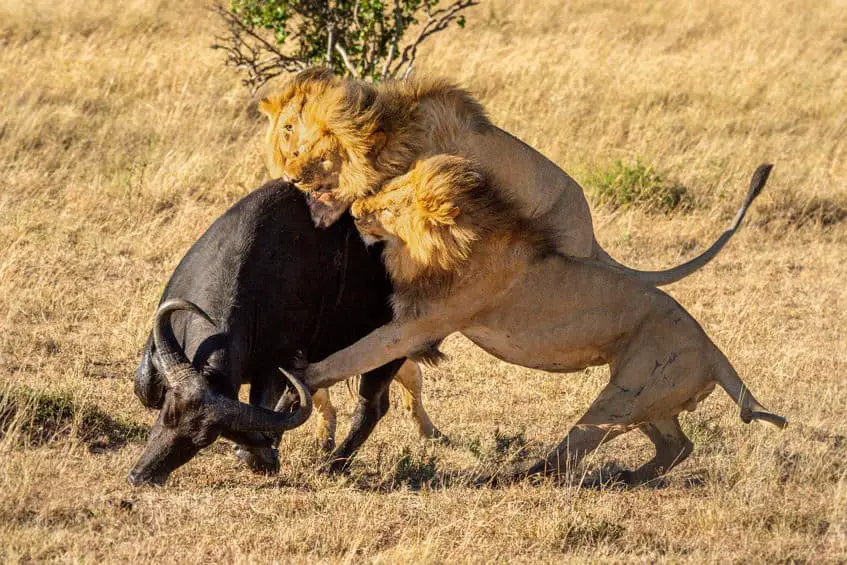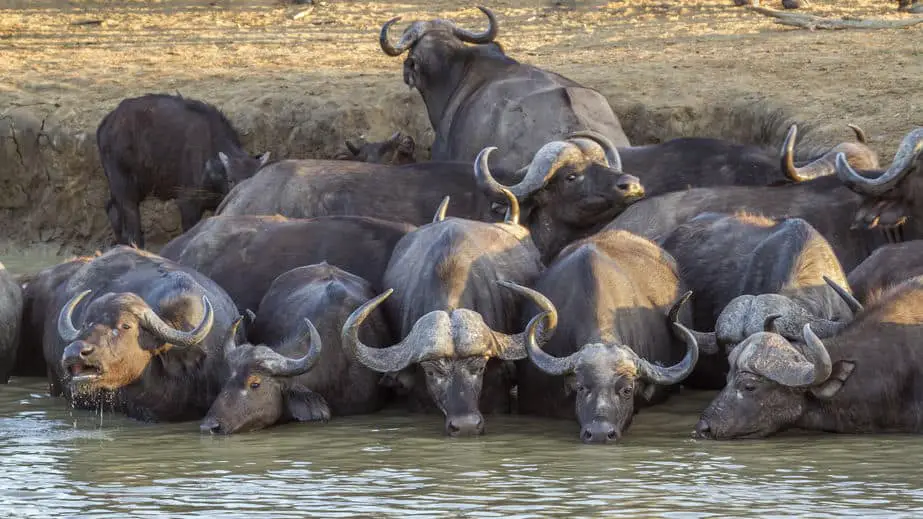
The Cape Buffalo, also called African buffalo, is considered to be the most dangerous of the so-called big five. I was quite surprised when I first heard this, so I decided to do some research and write this post about why the Cape buffalo is more dangerous than the other members of the big five.
It is estimated that the Cape buffalo is responsible for 200 deaths per year. If wounded but not killed, they can try to take revenge by sneaking around the hunter and striking from behind. They are thought to have killed more big game hunters than any other mammal in Africa.
Below is a more detailed resume of what I have learned about the Cape buffalo with a focus on what makes it more dangerous than the other four members of the big five and even one of the most dangerous animals in Africa.
The Most Feared Member of the Big Five
The Cape buffalo is a proud member of the big five which includes lions, leopards, elephants, rhinoceroses, and Cape buffalos.
The big five were originally named so because they were known to be both difficult and dangerous to hunt and successfully doing so was considered to be quite the achievement for trophy hunters back in the days.
The Cape buffalo females weigh from 350-620 kg. and the large bulls can weigh from 500 kg. and up to as much as 900 kg. They measure 150-175 cm in height.
If the massive size of this animal does not already seem at least a little bit frightening to you then let’s dive into some more scary facts.
The Cape buffalo has a reputation of being not only the most dangerous but also the most aggressive of the big five. Cape buffalos have killed more big game hunters than any other mammal in Africa.
If a hunter attempts to kill a Cape buffalo but fails to do so and ends up merely wounding the animal, the wounded cape buffalo can sneak around the hunter and wait until the perfect moment to strike from behind and kill the hunter.
An attacking Cape buffalo can be almost impossible to stop once charging. The forehead is so thick and massive that it can stop bullets from even some strong hunting rifles.
If a hunter manages to escape up into a tree while being chased by a Cape buffalo, he or she might as well prepare to get comfortable as the Cape buffalo can wait underneath the tree for several hours to get revenge.
As you can hear, a Cape buffalo can be plenty dangerous by itself but the large mammal is a highly social creature and tends to stay in groups of 10-20 animals. Being in such large groups gives them the advantage of outnumbering most enemies and they have been seen surrounding enemies and attacking from different angles.
Sometimes you can be lucky and see giant herds of Cape buffalo (preferably from a distance) of up to several thousand animals. These giant herds are, however, temporary and are primarily seen in relation to long-distance walks or during mating season.
In total, it is estimated that Cape buffalos are responsible for 200 deaths per year.
So as you can see, it is no joke when the Cape buffalo is sometimes being referred to as the black death or widowmaker.

Buffalos and Lions. Natural Enemies.
Cape buffalos and lions are natural enemies and can often be seen fighting. In fact, Cape buffalos are thought to be responsible for more lion deaths than any other animal.
If a pride of lions has taken down a cape buffalo, the rest of the cape buffalos herd can return the favor by attacking the lions as a group, and once one of the buffalos attack, they usually all attack.
Cape buffalos are so strong that they can use their massive foreheads and strong necks and heads to lift lions off the ground and toss them several meters into the air.
The Cape buffalo can also use its thick and strong horns to impale the lions and thereby killing them.
Cape buffalos have even been seen systematically seeking out and killing lion cubs which suggests an impressive intelligence in Cape buffalos.
But the rivalry goes both ways.
Lions are also often seen hunting and taking down Cape buffalos to eat them. The lions may attempt to sneak up on a single Cape buffalo that may have lagged a bit behind the rest of the herd and gotten isolated. Lions can also attempt to take down the youngest Cape buffalos from the herd as these do not pose as big of a challenge as the fully grown ones.
When fully grown, Cape buffalos have thick and dense ribs that work almost like armor that protects the chest and organs, making them a very difficult mammal to prey on but this does not seem to stop the lions, as Cape buffalos actually make up one of the most important food sources for lions in some parts of Africa.

When Cape Buffalos go Head to Head
Cape buffalos do not only fight against other animals but also individually.
Especially the big bulls can have some very heated face-offs where they go head to head in the most literal sense of the words.
In those face-offs, the bulls circle each other trying to intimidate the opponent by using their massive horns to ravage the soil and vegetation around them.
This can go on for several minutes and if none of the bulls are sufficiently intimidated by the opponent, the real face-off begins.
The bulls will get up to 30 meters apart and then charge towards each other at full speed, banging their rock hard foreheads and horns together repeatedly. The sound from the bulls banging their foreheads together is so loud that it can be heard from far away.
The incredible strength the Cape buffalo bulls have and the massive force behind their full-speed charges can lead to the weaker individual being tossed through the air.
The result of these bull-on-bull showdowns determines which of them is perceived as being the stronger individual within the herd which comes in handy for them when the mating season comes.
How to Escape an Attacking Cape Buffalo
You should never expose yourself to a situation in which you could become the target of an attacking Cape buffalo as this will almost certainly result in death.
Some other large mammals such as elephants are often seen mock charging which is when they pretend to charge at you but stops after a couple of steps. This is done to express dominance and threaten the approaching human or animal to get them to go another direction.
Cape buffalos do not mock charge and once they start charging, chances of escaping are extremely slim.
Cape buffalos can run up to 57 km/h so your only chance of escaping is to have a significant head start and quickly locate a tree you can climb up into before the attacking buffalo gets to you.
Once in the tree, you should be prepared to stay there for a while as an angry Cape buffalo can wait around for hours below the tree, waiting for you to come down so it can get revenge.
Where to See Cape Buffalo in Africa
Cape buffalos need to drink water twice per day on average which is more than many other African mammals. This limits them from straying too far away from water.
For this reason, Cape buffalos are primarily seen in savannas near water holes or in wetlands or riverbeds but they can also be seen in drier surroundings as long as there is water available nearby.
Cape buffalos are found in sub-Saharan Africa and are widely distributed all over most of the central and southern parts of the continent.
One of the best places in Africa to see giant herds of up to several thousand Cape buffalos is the Kavati National Park in Tanzania.
Recommended Children’s Book About African Wildlife
If you have kids who like African wildlife and are looking for a book to read with them, or if you are interested in an easy-to-read book full of fascinating information and great photos, I can recommend a great book that I bought recently.
The book I want to recommend is called The Ultimate Book of African Animals by National Geographic Kids. When I first ordered it, I didn’t know what to expect, but I was very pleasantly surprised when I opened it.
The book contains so much fun and interesting information about all our favorite animals from Africa and a lot you probably didn’t even know existed. From tiny lizards to massive mammals, this book covers them all and has beautiful photos of the animals in action.
You can buy the book on Amazon at the link below. It is an affiliate link, so I will earn a commission if you choose to use it.
